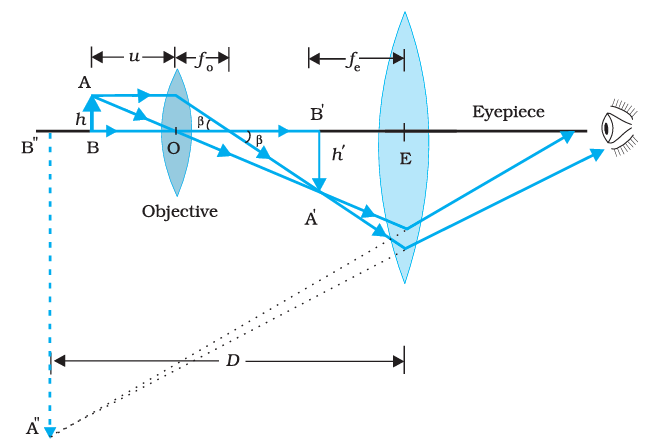Compound Lenses Thin Lenses In Contact
Compound Lenses Thin Lenses In Contact: In a basic lens system, a solitary lens is employed, in contrast to the compound lens system where the utilization of multiple lenses aligned along a shared axis is possible. The most straightforward form of such a compound lens setup involves the alignment of two thin lenses in direct contact. This article aims to delve into the realm of compound lenses, examining their distinctive properties.

The frequently utilized types of lenses encompass:
1. Convex Lenses (Converging Lenses)
2. Concave Lenses (Diverging Lenses)
As you may recall, we have extensively covered the characteristics of convex and concave lenses in previous sessions. Now, our focus shifts towards comprehending the intricacies of compound lenses.
Compound Lenses
The illustration below demonstrates a compound lens arrangement. Compound lenses are characterized by the presence of two thin lenses positioned on a shared axis, often in close proximity or bonded together.

Compound Lens Configuration
In cases where two thin lenses sharing an axis are positioned in contact with each other, the common focal length for the system can be determined using the following formula:
Where:
- is the combined focal length
- is the focal length of the first lens
- is the focal length of the second lens
Given that power is the reciprocal of focal length, a noticeable observation arises in this scenario. For thin lenses in contact, it becomes apparent that the combined power of the system results from the summation of the powers of the individual lenses.
However, if the lenses are not in direct contact but separated by a distance , the combined focal length can be computed using the subsequent formula:
Now, let’s put your understanding to the test with a simple problem: A bi-convex lens with a focal length of 10 cm and a bi-concave lens with a focal length of 20 cm are positioned in contact. Both lenses share the same refractive index. Calculate the combined focal length.
When delving into the realm of lens combinations, you may encounter the following terminology.
A Focal System
When the separation distance (d) between the two lenses equals the sum of their individual focal lengths (f1 + f2), the resulting combined focal length becomes infinite. This configuration causes the refracted light rays to become parallel to one another.
Achromatic Doublet
The arrangement of the lenses is designed to align such that two specific wavelengths, usually the extremes of red and violet light, converge to a focused point. This utilization represents an instance of employing a compound lens system to rectify chromatic aberrations, a phenomenon that can occur with single lenses.
Application of Compound Lenses
Compounded lenses are employed in telescopes and microscopes, combining two or more lenses to achieve the following objectives:
1. Minimize aberrations and flaws resulting from single lens usage.
2. Obtain an upright image of the object.
3. Enhance image magnification.
I trust you now have a clear comprehension of compound lenses.
The Purpose and Benefits
The application of compound lenses, particularly with thin lenses in contact, is multifaceted and impactful. Let’s explore the primary reasons behind their adoption:
- Aberration Correction: Single lenses often suffer from optical aberrations, leading to distortion, blurring, and color fringing in images. Compound lenses tackle this issue by carefully aligning and combining thin lenses. This alignment aids in reducing aberrations, resulting in clearer, sharper images.
- Chromatic Aberration Mitigation: The dispersion of light into different colors, known as chromatic aberration, is a challenge that can affect the quality of images produced by single lenses. Compound lenses help alleviate this problem by ensuring that light of varying colors converges more effectively onto a single focal point.
- Erect Image Formation: Erecting images – producing images that are not inverted – is crucial in various optical devices, such as microscopes and telescopes. Compound lenses, when configured correctly, can generate upright images, enhancing the usability of such devices.
- Magnification Enhancement: The integration of thin lenses in contact can lead to increased magnification capabilities, which is vital for applications requiring close examination of intricate details.
Read More
Frequently Asked Questions – FAQs
What are compound lenses composed of?
Compound lenses are made up of two or more thin lenses positioned in contact with each other along a common axis.
What is the purpose of combining thin lenses in contact?
Combining thin lenses in contact helps to correct optical aberrations and improve the quality of images formed.
What advantage do compound lenses offer over single lenses?
Compound lenses help to correct chromatic aberrations that can occur with single lenses, leading to improved image quality.
Where are compound lenses commonly used?
Compound lenses are frequently used in telescopes and microscopes to achieve various optical benefits, including increased magnification and reduced defects.
Can compound lenses be used for erect image formation?
Yes, by properly arranging the thin lenses, compound lens systems can produce an erect image of an object.
What is the significance of correcting chromatic aberrations?
Correcting chromatic aberrations ensures that different colors of light converge to the same focal point, resulting in sharper and clearer images.